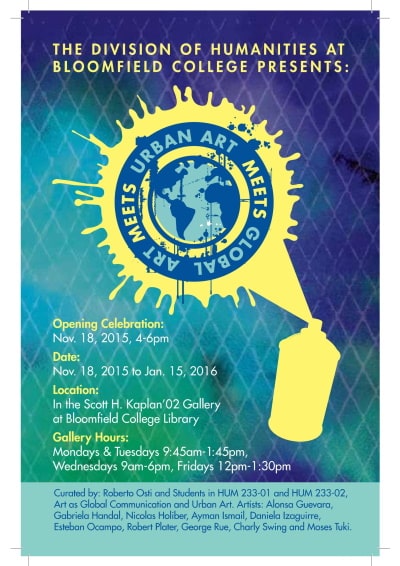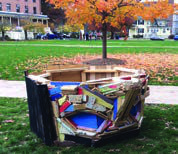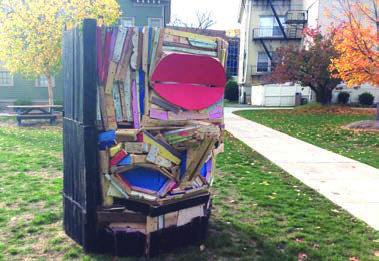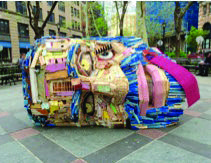ROBERTO OSTI
Urban Art Meets Global Art
This exhibit and the temporary installation in the campus Quad are created as part of the current Arts & Culture courses in the Division of Humanities of Bloomfield College. The courses are entitled “Urban Art” and “Art as Global Communication.” This event also introduces the Arts & Culture curriculum to the college and the public.
One year ago, I was invited to create a new course of study by then VPAA Dr. Marion Terenzio in connection with the Chair of the Humanities (and my wife) Dr. Angela Conrad. The idea was to create courses in the Arts that would be available to students from all disciplines and allow them to see themselves and their work in connection with the art world. The scope of the Arts & Culture courses is to study the role of art and art making in today’s world and its impact on modern society. The courses that form the core of this curriculum are intended to create connections between the arts and other disciplines. The Urban Art course explores the role of art in the urban landscape and the infl uence it can have in improving the quality of life for those in the communities.
Art as Global Communication explores the cultural connections that can be forged through the interaction of artists from different countries and cultures. In spring 2016, we will be offering courses in Mystical Art and in Art of the Renaissance and Anti-Renaissance.
Other courses will include, The Value of Art (economics) and Art and Healing (health care), among others. The main consideration in designing this course of study was to make it relevant to the realities and needs of today’s employment market and our student population.
Dr. Conrad’s 15 years of experience of teaching full time at Bloomfi eld College combined with my own experience teaching Bloomfield College tudents since 2003 permitted us to develop a very clear notion of students’ interests and needs. Students enrolled in these courses come from different majors: such as Business, Broadcast Journalism, Social Sciences and the Humanities. The skills students developed this semester can be directed toward a variety of professional activities: like museum curating, writing and reporting about the arts, urban planning, arts promotion as well as critical thinking. Students are responsible for selecting the works of this exhibit, contacting and interviewing the artists, and writing the catalog text. Thank you to Joan Acosta, Andrew Adomanis, John Eason, Awtumn Johnson, Kenneth Lamons, Erik McRimmon, Jada Pickett, Brenda Quinones, Aleiyah Richardson, Brionna Singleton, Devin Conlon, Angelica Velez.
My special thanks go to Prof. Nancy Bacci and the Division of Creative Arts & Technology for their support of these fi rst two courses. Nancy made the art gallery available and connected me with Prof. Nancy Fischer who took care of designing the catalog and the promotional materials for the exhibit. In addition thank you to Paula Craig for her role in the logistics and Quad Event.
Thanks also to Devrim Ozgur, James Ricks IV, John Huynh and Categrafi ca who printed some of the images in the gallery. Finally, I want to thank my students for the work they did researching, interviewing and writing text for the catalog, participating at the outdoor art installation on the Quad, taking photos and footage of the event for media purposes and for contributing to the organization and hanging of the show in the gallery. This was a complete learning experience for all the people that participated in it.
–Roberto Osti, Curator
URBAN ART
Urban Art is all around us, but can we see it?
More and more people are coming to understand that art in urban settings affects the quality of life in our cities. From a commercial perspective we see that neighborhoods with public sculpture, paintings and arts events usually enjoy higher real estate values. Having art exhibited in public places implies that neighborhoods are safe—art can be displayed without fear of vandals and people who live there take care of their public spaces. Art attracts visitors who will want to eat out and shop in those areas. Therefore, public art promotes local businesses.
But more than that, public art creates a sense of identity for people in a place who grow more attached to the neighborhoods and see themselves refl ected in it. The proliferation of programs that promote art in urban settings such as New York City’s “Art in the Parks” or “Poetry in Motion,” and Philadelphia’s or Jersey City’s mural art programs attest to the positive effect that public art has on urban communities.
More and more people are coming to understand that art in urban settings affects the quality of life in our cities. From a commercial perspective we see that neighborhoods with public sculpture, paintings and arts events usually enjoy higher real estate values. Having art exhibited in public places implies that neighborhoods are safe—art can be displayed without fear of vandals and people who live there take care of their public spaces. Art attracts visitors who will want to eat out and shop in those areas. Therefore, public art promotes local businesses.
But more than that, public art creates a sense of identity for people in a place who grow more attached to the neighborhoods and see themselves refl ected in it. The proliferation of programs that promote art in urban settings such as New York City’s “Art in the Parks” or “Poetry in Motion,” and Philadelphia’s or Jersey City’s mural art programs attest to the positive effect that public art has on urban communities.
Nicolas Holiber, who created the sculpture “Vessel Head” on the Quad, told me of an episode that testifi es to how people grow sensitive to the art in their neighborhoods. As he was installing a sculpture in Tribeca Square in New York, passers-by often stopped and asked him what he was doing, and what artwork he was installing as though they were to give him permission to install the work in “their” square—making sure it was good enough. Some stopped to ask what he did with the other sculpture, the piece that was on display before his. He did not know the answer, but this interaction shows that people do care and appreciate the art in their neighborhood.
Now Holiber’s “Head of Goliath” has been moved to another exhibit location to make room for the next installation in Tribeca Square and the space feels empty. Surely, visitors sitting on the benches look on the open square wondering what happened to Goliath, and missing it.
Having public artwork displayed in neighborhoods is not prohibitively expensive. Artists like Nicolas Holiber and Robert Plater (author of the mural on the quad) can create works for sums that municipalities can afford. Plater only needs a wall and some paint. Holiber uses recycled wood from a variety of sources. They both developed techniques that are relatively quick and economical. They do not create their works to be “permanent” which also limits the costs, and they can be rotated or substituted to add to the outdoor gallery effect. When people in communities use public money to add art to their environment, everyone wins. They become able to connect to artistic expression of their identities and show they care for their homes.
Now Holiber’s “Head of Goliath” has been moved to another exhibit location to make room for the next installation in Tribeca Square and the space feels empty. Surely, visitors sitting on the benches look on the open square wondering what happened to Goliath, and missing it.
Having public artwork displayed in neighborhoods is not prohibitively expensive. Artists like Nicolas Holiber and Robert Plater (author of the mural on the quad) can create works for sums that municipalities can afford. Plater only needs a wall and some paint. Holiber uses recycled wood from a variety of sources. They both developed techniques that are relatively quick and economical. They do not create their works to be “permanent” which also limits the costs, and they can be rotated or substituted to add to the outdoor gallery effect. When people in communities use public money to add art to their environment, everyone wins. They become able to connect to artistic expression of their identities and show they care for their homes.

Nicolas Holiber

Robert Plater

Nicolas Holiber
This piece is created out of wood, nails, screws, and other found objects and is about 11’x 5.5’. His studio is located in Greenpoint, Brooklyn and is fi lled with his paintings and sculptures. The material he uses to create his sculptures is mostly wood from shipping pallets he fi nds in recycling centers. It is the perfect material for the technique he created to produce his works and he also fi nds himself saving money that way. Nicolas uses materials like plaster, paint, yarn, feathers, and bones. The works he creates with these recycled materials are really beautiful and unique. Nicolas is extremely comfortable and engaging when telling to us about his studio, his work and his creative process. He gives us a sense of true humility.
He tells us that his work is continuously evolving and developing and this is an important aspect of making art. This past January, he found himself teaching two classes of sculpture to high school students. He started painting and sketching at a young age and eventually started creating wooden sculptures. There is always room for growth and improvement. An important part of his inspiration is his mother who is an artist who works with ceramic. She encouraged him to pursue his passion for art. When he creates a piece, he starts with nothing, or “a mess” as he states. He creates preparatory sketches and starts nailing pieces of wood together using a technique he developed and refined in these last three years.
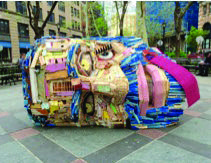
Head of Goliath
The representation of King David defeating the giant resembles Nicolas defeating his adversities in the city: “People come to New York to be the underdog and beat whatever obstacle is in front of them,” Holiber explained in a statement. “For myself and many friends of mine, New York is the Goliath. . . . Head of Goliath will be a connection to the past and serve as a symbol of the classic underdog tale that is shared by so many in this amazing city” (Holiber).
- by Brenda Quinones
Where are you originally from?
“I grew up in a small town north of New York City.” When did you realize you wanted to be an artist? “I think I was in middle school... I was always drawing and painting but I remember I painted a picture of a snowboarder in the air and thought, “oh maybe this is something I can do when I grow up”.
What kind of preparation goes into starting a project?
“Other than gathering materials, I don’t do much prep work for a piece. I may occasionally make a sketch to work from, as was the case with Head Vessel at Bloomfi eld College. But the work gets created very organically and to start I just pick up a few pieces of wood and get to work.”
Do you prefer creating sculptures or paintings?
“I don’t prefer one or the other but they each fulfi ll a different creative outlet for me. When I make the sculptures it is defi nitely more of an active experience, physically intense. With painting I can focus more on a single perspective and creating one image. I enjoy doing both at the same time.”
What is your feeling on the human face given how uniquely it is used in your works?
“Faces are usually the fi rst thing we identify, they give us all the information we need from someone. I use the face to portray emotion and connect with my audience.”
Do you sketch out a project before you build it or do you have an idea and manipulate it as you build?
“If I use a sketch, it will be very loose and just a guide to start from. It’s very important for me to have the freedom to make changes and edit the piece as I’m working on it. This process allows me to stay engaged in what I’m making and also allows for the unexpected to occur.”
Your work is arresting, it has an archetypal quality that immediately relates to the viewer, how did you decide to use Classical mythology references?
“It wasn’t so much a decision for me as it was just an extension of my interests. I love classical mythology, or any mythologies really and I want my work to be connected to that history.”
You are using recycled materials to create your artwork, was it out of necessity or for a more deliberate reason?
“It began as a necessity that developed into a deliberate reason. I was collecting shipping pallets when I began to make sculpture because it was an abundant material that cost me next to nothing. As I used the found/ reclaimed wood more and more I realized that the content of the work could also relate to the materials used.”
Your outdoors works are not thought to be permanent, can you elaborate on this aspect?
“Nothing is really permanent. Not even the largest sculptures made of steel or bronze, although they do last a very long time. My work, because it is made of organic material, will show the effects of time faster than a metal sculpture. But this deterioration is also part of the work itself and is used to show the ephemeral nature of all things.”
What do you think the role, the scope of urban art is in general and more specifi cally what do you hope to achieve with your outdoor pieces?
“Urban art, or public art I think has a responsibility to engage the public on some level. Deep down, my outdoor pieces are about human nature. There are a lot of references to antiquity and mythology, but really it’s all about what it means to be human; with all the emotions and inevitabilities that come with it.”
You produced an incredible amount of artwork in just a couple of years or so, how do you organize your time to be able to work with such an intensity and produce work of constant high quality?
“There is always more work to be done! I spend almost all of my free time in the studio. I work (at a day job) several days a week but I’m thinking about what I want to make all the time. There’s not a lot of time for me to procrastinate so when I’m at the studio I try to stay focused and work as hard as I can.”
What is your next project?
“I will be making a new body of work based on Homer’s Iliad, for a solo show at Gitler & _____ (www.gitlerand.com) this March.”

Robert Plater
The degree was important, but his goal was more, his focus on making art and growing as an artist. Most of Plater’s work is inspired by the simple things like childhood cartoons that he transforms, which he charges with his own messages. Like many artists, Plater used personal issues he faced as a source of inspiration. For example, he explained how a nasty break up had that infl uenced his many pieces. This was a very diffi cult moment for Plater that he dealt with in his art.
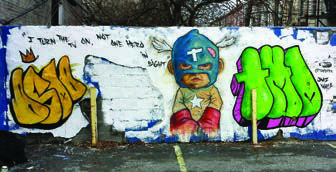
Adventure Time
- by Brenda Quinones
Is your art work mostly inspired by your neighborhood? / Are masked images infl uenced by environment?
“In many ways, the artwork is inspired by my neighborhood. Sometimes, the environments are also symbolic or representative of environments similar to where I grew up in East New York Brooklyn and other impoverished, under praised neighborhoods. The masked/ hooded children and characters are infl uenced by the environment in the sense that they either wear certain masks to survive their environments or are forced into wearing suits etc...”
Are there any cultural boundaries that infl uence your artwork? / Do you think your ethnic background plays a major role in your success or not?
“They certainly do. There are always subtle hints to race and politics in the work relating to many of my experiences as a person of color. I believe that touching on the topic of race using the characters in my paintings and murals have allowed me to open an interesting dialogue about race as it pertains to people’s perceptions of children in urban environments and even what race means to people within the very broad world of art and image making.”
Are there any cultural differences you believe hinder artists in general?
“Sometimes I believe this to be the case. Not always but from my experience, I have off and on touched on these topics because I deem them important. Many times viewers and consumers of art have not always been open to some of the political and social topics. In more commercial settings such as art institutions and certain high end art galleries etc, I find that people usually shy away from artists that paint about certain topics unless of course the artist is famous and can produce profi table work.
Have you ever gotten in trouble from your art? / Has anyone ever opposed your artwork?
“Fortunately, I haven’t run into many issues surrounding the themes and story of my artwork but I have seen it happen to a lot of artists.”
Is including children in your work important? / Do you feel more drawn to children when including them into your artwork? If so, why?
“Children are very important because of how much of our character/ personality development happens during childhood. I also use children as standing for myself as a child to tell stories about certain issues I was dealing with (identity issues, personality, family, etc.).”
How do you remain inspired during economic dilemmas?
“It’s never easy but I constantly draw. I try and draw everyday as a release for tensions I might be experiencing.”
What message do you try to perceive in your artwork as a whole? / What themes do you pursue?
“Overall my work is about life. I am limited to speaking about this theme through my own skewed perception of life using my own life experiences. Many of the themes are about identity, self relevance and the idea of persona. The work is also about the anxiety and frustrations that might be associated with these themes.”
What responsibilities do you think you have as an artist?
“I always felt that artists have a responsibility to function as documentarians. Through our work, we have the ability to tell a story about our society and give some insight into what issues, interests, and concerns are relevant.”
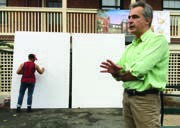
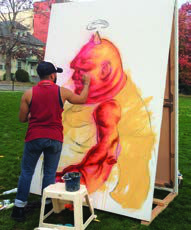
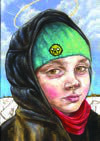
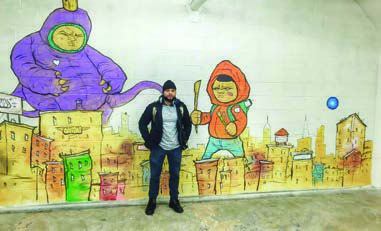
ART AS GLOBAL COMMUNICATION
Art communicates, expresses and defines the cultural identity and values of any society in time.
The idea of this exhibit is to bring together artists from diverse social, economic and cultural backgrounds to look for similarities and specific identities. We search for commonalities in artistic expression originating in areas remote from each other, but at the same time we see how each of us can be enriched by others’ different experiences and views of the world. The virtual world can give us a glimpse into many of these differences, but interacting with real people instead of a screen is far more enriching and real. More and more of our interaction is mediated by entities that shield us from the real world, paradoxically limiting our connections.
We met with most of the artists that are included in this show and we had occasion to interact with them on our campus, asking questions that sometimes were quite personal that could only have been asked after the connection allowed by a face-to-face meeting. In some cases, the artists’ experiences were easy for students to understand because they were parallel to our students’ experiences. In other cases, the inspiration for the artwork came from experiences so unique to their individual lives that they were unfamiliar to students. This, too, was valuable because it exposed us to life conditions that we did not know about before. For example, one artist comes from a nation where women’s freedoms are very limited by the government. It was my intention to include her work in the exhibit and we began selecting from her works. When she was set to give the interview to the student who contacted her, she suddenly had to travel back to her home country and we lost contact with her.
Because her work expresses opinions about the political situation in her country, we were left with a dilemma: should we keep contacting her, discussing her art and her ideas using a medium that could be monitored by the government, possibly endangering her? We preferred not to risk it and we are still waiting for her return to the United States so that we can take up the conversation. This was another occasion for the students to come in contact with social and political situations from distant parts of the world.
The artists included in this show come from places as far removed from here as Nigeria, Colombia, Ecuador, and Egypt. Some are of mixed ethnic origin: African-American/Puerto Rican; Peruvian/Japanese; Jewish/Italian/Polish and so on. Ethnicity is a concept that is increasingly difficult to define.
The idea of this exhibit is to bring together artists from diverse social, economic and cultural backgrounds to look for similarities and specific identities. We search for commonalities in artistic expression originating in areas remote from each other, but at the same time we see how each of us can be enriched by others’ different experiences and views of the world. The virtual world can give us a glimpse into many of these differences, but interacting with real people instead of a screen is far more enriching and real. More and more of our interaction is mediated by entities that shield us from the real world, paradoxically limiting our connections.
We met with most of the artists that are included in this show and we had occasion to interact with them on our campus, asking questions that sometimes were quite personal that could only have been asked after the connection allowed by a face-to-face meeting. In some cases, the artists’ experiences were easy for students to understand because they were parallel to our students’ experiences. In other cases, the inspiration for the artwork came from experiences so unique to their individual lives that they were unfamiliar to students. This, too, was valuable because it exposed us to life conditions that we did not know about before. For example, one artist comes from a nation where women’s freedoms are very limited by the government. It was my intention to include her work in the exhibit and we began selecting from her works. When she was set to give the interview to the student who contacted her, she suddenly had to travel back to her home country and we lost contact with her.
Because her work expresses opinions about the political situation in her country, we were left with a dilemma: should we keep contacting her, discussing her art and her ideas using a medium that could be monitored by the government, possibly endangering her? We preferred not to risk it and we are still waiting for her return to the United States so that we can take up the conversation. This was another occasion for the students to come in contact with social and political situations from distant parts of the world.
The artists included in this show come from places as far removed from here as Nigeria, Colombia, Ecuador, and Egypt. Some are of mixed ethnic origin: African-American/Puerto Rican; Peruvian/Japanese; Jewish/Italian/Polish and so on. Ethnicity is a concept that is increasingly difficult to define.

Moses Tuki

George Rue

Gabriela Handal

Esteban Ocampo

Daniela Izaguirre

Charly Swing

Aymann Ismail

Alonsa Guevara
- Continue
